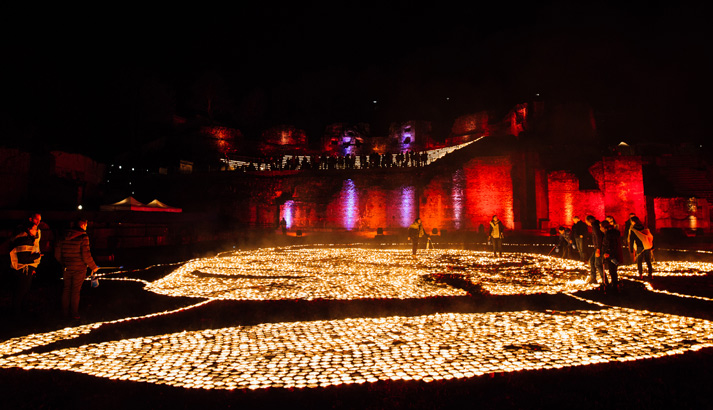From 8 December to the Festival of Lights
Ever since Lyon was founded, light has held a special place in the city and each year on 8 December, this special connection radiates throughout the city. The Festival of Lights is an international event renowned for its temporary light installations during which the city is metamorphosed for four magical evenings, reconnecting with a popular tradition dating back to 1852. That year, against a backdrop of social unrest, recurring floods and radical urban change, the decision was taken to erect a statue of the Virgin Mary on Fourvière Hill.
The inauguration was scheduled for 8 September, the date of the traditional procession of Aldermen, but flooding delayed delivery of the statue. The event was therefore postponed to 8 December, the Feast of the Immaculate Conception. But once again, official ceremonies had to be abandoned due to inclement weather. Seeing the weather improve as night fell, the people of Lyon spontaneously placed lit candles on their window sills and balconies; a symbol of the people coming together in a spirit of solidarity. The tradition of 8 December continued over the following decades and the citizens of Lyon are now very attached to this popular annual event.

Lyon - A pioneer in illumination
In the 1960s, shop-window illumination competitions, especially among food shops, continued this tradition in a new form. They marked the start of the Christmas season and illuminated the religious celebrations of 8 December. Then in 1989, thanks to an avant-garde public lighting policy, Lyon adopted its first Plan Lumière and added a new chapter to its history. This plan to enhance the city by illuminating heritage sites revealed the excellence of Lyon in this area; it was the first European city to launch such a project.
The lighting gradually began to take on more meaning – light embellished the squares, streets, bridges, riverbanks and rivers themselves. Lyon emerged from the shadows to become the city we know today, namely a city renowned for the beauty of its heritage, which becomes truly special when night falls.
Lyon's heritage in the spotlight
The Festival of Lights emerged from the popular tradition going back to 8 December 1852, when the residents of Lyon placed candles in coloured glasses on their window sills to celebrate the installation of a statue of the Virgin Mary on the Fourvière Hill. Entire districts of the city were lit up, transforming the facades of buildings in a show of lights.
To commemorate this event, on the days surrounding 8 December every year the people of Lyon celebrate the lighting up of their city, showcasing its living heritage. Light, symbolising the renewed identity of the city, takes visitors on a journey through a poetic world, filled with magic and dreams.
The Festival shows the heritage of the Presqu’île and Vieux-Lyon in its best possible light, illuminating its Renaissance facades and majestic buildings. Thanks to the artists' creations, Lyon’s most beautiful buildings serve as the backdrop for huge, magical son et lumière installations in which they are visible – or invisible.
Light is now an integral part of Lyon's identity, revealing the beauty of its architecture and creating magnificent nocturnal landscapes.